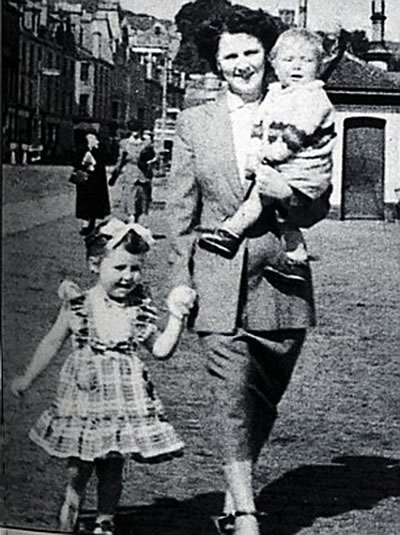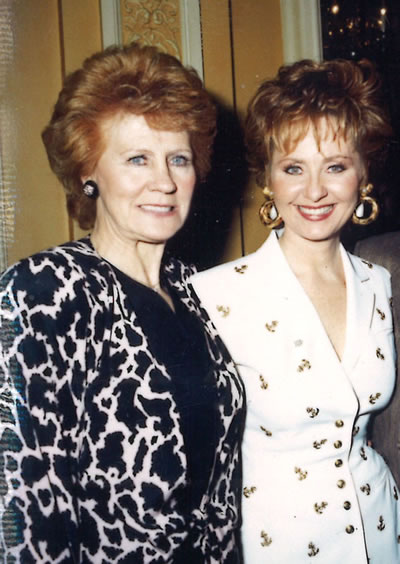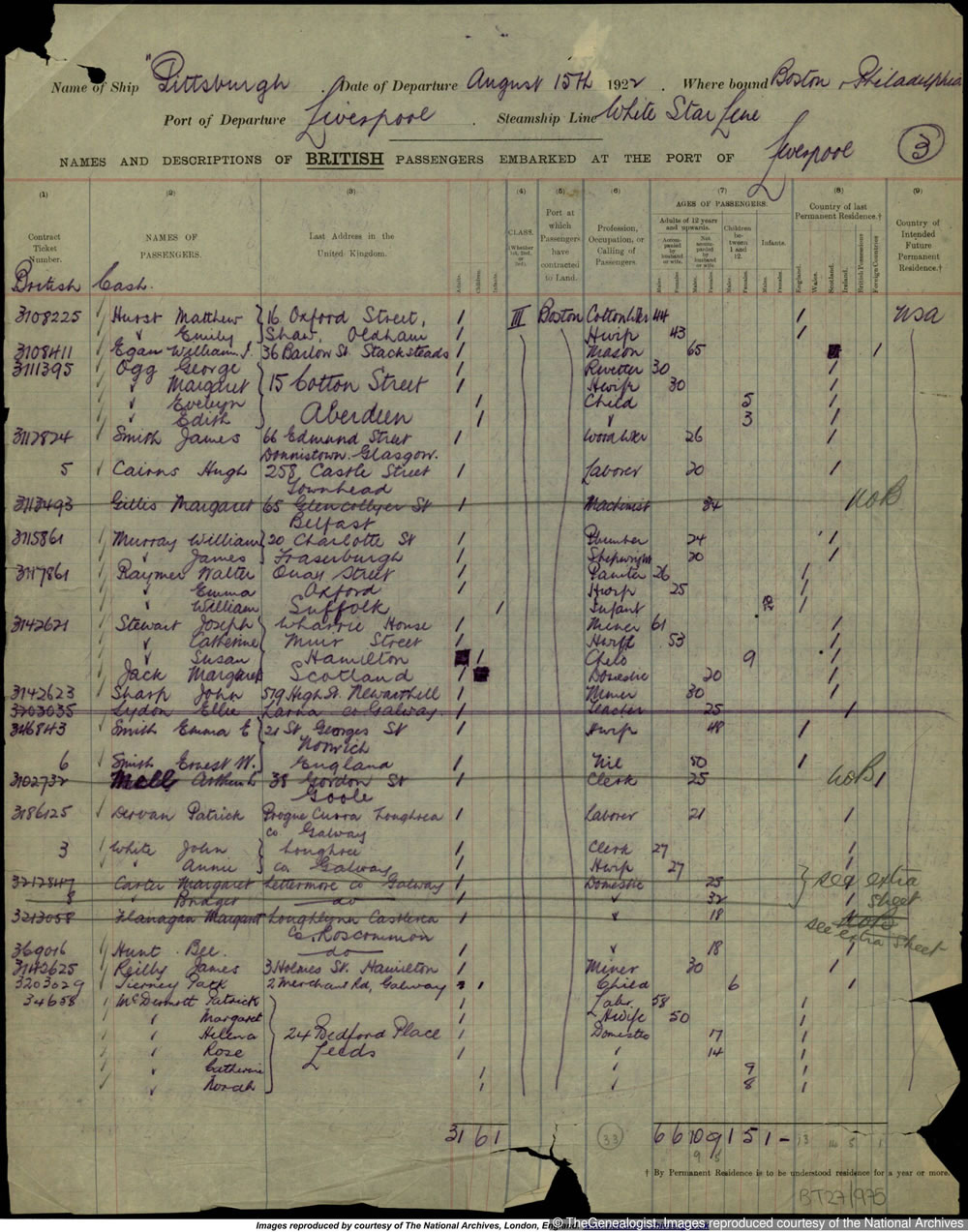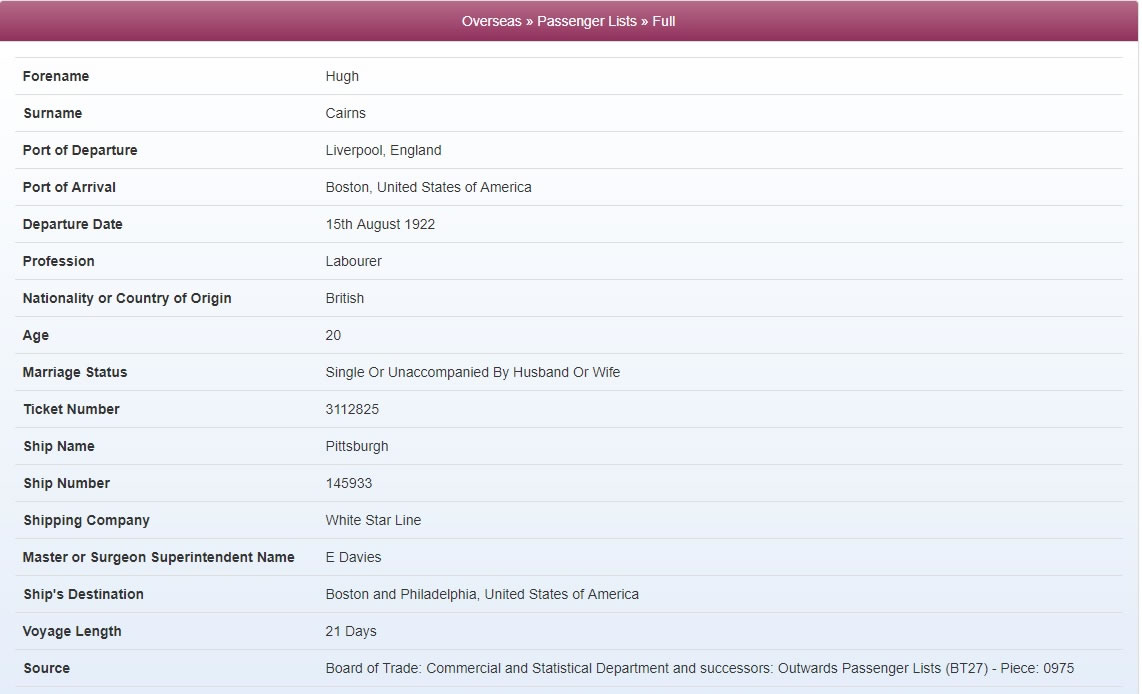Back in 1965 the Glaswegian popstar Lulu shot to fame she was just 15 at the time and her singing career continues to this day.
I go on that stage; I just love it. I’m blessed to still be able to do it and to still enjoy it. It’s unbelievable.
Best known for the hit record Shout, she has won the Eurovision song contest, topped the charts with Take That, and is still to be found on the tour circuit and releasing new material.
I don’t know what I’m going to find, but I have no high-falutin’ ideas. I’m not waiting to find out I’m really a princess! I know!
Now known as Lulu Kennedy-Cairns, OBE, she was born on the 3rd of November 1948 in Glasgow. At that time she was named Marie McDonald McLaughlin Lawrie and as the eldest of four children all her questions about her family’s past begin with her mother.


The story of my mother is big secret. Basically she had been given away as a baby.
Lulu never met her mother’s biological parents and believes that she’s never even seen pictures of them either. This strange situation raises a question:
The real essence of this is why did they give my mother away? That’s the real thing. That’s what’s so confusing.
To begin her family history quest, Lulu starts by getting together with her brother Billy and her son Jordon to review what they already know of their family history. She is keen to research her mother Elizabeth’s background and crucially try to discover why her mother the middle child of seven was the one who seemed to have been singled out to be given up by her parents and raised by another family.
Lulu and Billy are seen in the Who Do You Think You Are? programme telling Jordan that they believed that their mother was an infant at the time that she was taken in by the McDonald family. Elizabeth eventually found out that the McDonalds weren’t her birth parents and this greatly upset her to think that she’d been given away by her natural parents. Elizabeth was able to get to know her real siblings the Kennedy-Cairns, but there always remained secrecy surrounding the issue.
Although it wasn’t spoken, we understood – don’t ask too many questions, don’t push it. There’s a lot to be answered.
To find out more about her maternal grandparents and see what she can discover about the circumstances of her mother’s adoption, Lulu heads to her home city of Glasgow in the TV programme. The facts she already knows are that her mother had been born on 25th September 1927. Elizabeth’s birth mother (Lulu’s grandmother) was called Helen Kennedy Cairns neé Kennedy while Helen’s husband, Lulu’s grandfather, was named Hugh Cairns. Lulu gets a shock when she realises that Helen Kennedy Cairns died in 1935, at the age of only 31 and by that time she had already given birth to 7 children. With the year of death Lulu is able to calculate that her mum Elizabeth would have been just 7 at the time of her mother Helen’s death. Notwithstanding this she didn’t discover that she was adopted until she was in her early teens. This saddens Lulu that her mother had never got to know her own birth mother. Lulu is keen to try and find out more about Elizabeth’s biological parents.
I would absolutely love to see pictures, I would like to know what my grandparents looked like. Do I look like them?
By visiting Glasgow, Lulu is able to meet some members of the Cairns family: her uncle Jim, who is her mother’s only surviving brother, and also her cousin Eleanor the daughter of Lulu’s Aunt Nelly, the older sister of her mother. It turns out that it had been Nelly who had gone looking for Elizabeth at school and had been the one to reveal to her that she was given away. With this in mind Lulu meets Eleanor in the hope that she might have some insight into what happened.
Jim and Eleanor are able to show Lulu a picture of her grandmother Helen which Lulu has never seen before. Eleanor is also able to disclose that her mother Nelly had told her that their grandmother Helen liked to go out dancing and this was despite having 7 children at home.
What comes as a surprise to Lulu in this family history research is that she sees herself as a small girl in a picture from a family wedding. Lulu has no memory of the incident and she had believed that she had never met her grandfather, Hugh Cairns the picture is proof that she almost certainly did.
Lulu is also shown another picture of Hugh in which his face shows a prominent scar on the left side that runs from his mouth to his ear. Jim and Eleanor were not sure how he had received the scar, though they had heard stories and it had been very common at the time to see people with facial scars. As a young man Hugh had worked for the Caledonian Railway.
Lulu discovers that her grandparents had a tempestuous relationship. There was also a religious divide where by Hugh’s family were Catholic and Helen’s were Protestants and members of the Orange Order. This difference in background caused both sides to make attempts to break the couple up. As a result Lulu learns that they were constantly splitting up and then getting back together. Eleanor explains that Helen and Hugh were very much in love: “they couldn’t live with each other, but they couldn’t live without each other.”
After the death of his mother, Helen, Lulu’s Uncle Jim stayed with an aunt whilst his other siblings lived with their father and had to practically raise themselves. Eleanor is able to relate her mother’s stories of stealing bread and milk as children because Hugh was often drunk, or away from the house. Jim agrees that living with their father was hard for those left behind and so he thinks that both he and Lulu’s mother were fortunate to have escaped that upbringing. Lulu discovers that her mother, Elizabeth, once asked why she had been the one to be given up. Her sister Nelly had said that “you were the lucky one”. This is a consolation for Lulu. She is pleased that her mother had fared better by being brought up with the McDonald family even if it had been hard for Elizabeth who would have felt that she had been abandoned.
The situation that led to Lulu’s mother being given up for adoption remains a huge puzzle to the star. Her hope is that by discovering more details about her grandparents that she may be able to unearth why it was that Elizabeth had been given away. Her hunt for answers takes her to the Springburn Railway Depot to meet historian Jim Smyth. This was where her grandfather Hugh Cairns had been employed from the age of 14. He had begun working at the depot in 1916 as a foundry labourer having left school at the earliest possible age. His unskilled low paid work was typical for most Irish Catholics. This part of the city’s population were often denied the apprenticeships that were open to their Protestant coworkers and so they would be consigned to a life of manual work for a low wage. With the outbreak of the First World War, however, Glasgow’s heavy industries needed men such as Hugh and so work was there aplenty. Notwithstanding this, however, Lulu’s grandfather appears to have a poor record for holding a job. The historian shows Lulu Hugh’s employment records, that catalogue her grandfather going in and out of a number of jobs at the railway. The reasons that he was frequently being laid off were for “bad timekeeping” and “inattention to work”. In 1922 Hugh eventually leaves the railway company of his own accord and there is a reference from Hugh’s employers that was granted to him because he was intending to emigrate. Lulu reads:
Access Over a Billion Records
Try a four-month Diamond subscription and we’ll apply a lifetime discount making it just £44.95 (standard price £64.95). You’ll gain access to all of our exclusive record collections and unique search tools (Along with Censuses, BMDs, Wills and more), providing you with the best resources online to discover your family history story.
We’ll also give you a free 12-month subscription to Discover Your Ancestors online magazine (worth £24.99), so you can read more great Family History research articles like this!
‘This is to certify that Hugh Cairns has proved himself to be a good workman and is a good timekeeper’ – they lied! How nice of them!
Wanting to find out where her grandfather had gone, she does a search of the passenger lists online. A search on TheGenealogist finds Hugh, aged 20, on a ship bound for Boston If we look at the right hand column we can see that Hugh had declared that he intended to stay in America indefinitely. Further research finds that Lulu’s grandfather didn’t stay long in the U.S.A as he traveled back to the U.K. via Hamburg a few months later. With this new information Lulu speaks to her cousin Eleanor to see if she can help understand what the story was behind this twist. Eleanor describes how Hugh’s Catholic family, disapproving of the relationship between Hugh and Helen, had clubbed together and paid for his passage to America in order to get him away from their grandmother. They hadn’t banked on Hugh missing Helen so much that he got himself employed on a German tanker making the return voyage across the Atlantic to Hamburg.


To see what had happened to her grandparents after they got back together, Lulu turns to historian Bill Knox in the Winter Gardens on Glasgow Green. He is able to show Lulu the 1923 birth certificate of Colin, the first of Hugh and Helen’s children, revealing that her grandparents were unmarried and that Colin was illegitimate. This would have carried quite a social stigma at that time. The document also reveals that the couple were living apart, she in Norman Street, whereas Hugh was at Castle Street Glasgow. By using a historic map of Glasgow the historian explains that although the city wasn’t completely segregated along sectarian lines, Helen’s address in Bridgeton was associated with the Protestant Orange Order, whereas Townhead was an area with a high concentration of Catholics. Both areas were depressed, grubby, and jam-packed in the years between the two wars.
Lulu is shown a second birth certificate for another illegitimate child, with the couple still living apart in the same two addresses. It is noteworthy from the official document that Hugh and Helen had gone to register the birth together; something that Lulu sees as a sign of her grandfather’s commitment to his offspring:
I imagine that the families absolutely refused to allow them to get married, but they couldn’t keep them apart.
Eventually, however, Hugh and Helen finally marry each other in 1925 which pleases Lulu. The certificate reveals that the marriage was an ‘irregular’ one being an informal Scottish marriage without any religious ceremony. This was often the only option that would be available to couples who came from differing denominations. Hugh and Helen would have risked being cut off by their families if they had married against their families’ will.
Understanding the difficulties that her grandparents faced, Lulu was keen to seek out the records of her mother’s “adoption” to see if they threw light on why Elizabeth was given up. For this Who Do You Think You Are arranges for her to meet adoption expert Professor Kenneth Norrie in the Mitchell Library.
Lulu is able to find her mother’s name in an index of infants who were living independently of their birth families. The professor explains that Elizabeth had not been taken into care but that the records indicate that her parents had voluntarily given Elizabeth to a foster family in a private arrangement where the birth parents had to pay for their child’s care. To make certain that the children were well looked after the local authority sent inspectors to regularly visit the children in their foster homes. The records show that Lulu’s mother lived with the McCoid family initially for one month from the age of 6 months old. The cold words upset Lulu:
The actual heading is, beautiful wording, ‘how disposed of’. It pains me, I have to say.
The circumstances shock Lulu when she finds out that her grandfather Hugh was actually serving a month in prison at the time of the fostering. Kenneth draws her attention to the fact that the records show that the McCoid’s were not paid for looking after Elizabeth and this resulted in her mother being taken in by the McDonald’s instead.
The visitation records that the programme finds disclose that by May 1928 Hugh was reported to be in jail and that Helen had disappeared. The records also note that the McDonalds had provided a loving and stable home for Lulu’s mother. This was despite a lack of interest or any payment that was forthcoming from her parents. Lulu finds it emotional to read the inspector’s reports about her mother’s childhood. There are lines that reveal that the “child went to school yesterday for the first time and is very pleased with herself”.
I’m crying and I’m laughing at the same time, I can just see her…she was well loved and cared for, and felt secure.
The couple reunited sometime later as they had a further three children after Lulu’s mother Elizabeth. The singer is keen to find out how the family breakdown occurred. She meets historian Dr Andrew Davies at the Old Glasgow Central Police Station, who she hopes can explain why her grandfather was in prison. A Duke Street prison record dated 1918 ten years before her mother’s adoption reveals that the 16 year old Hugh had been imprisoned for assault and for stealing £100 from a safe.
Access Over a Billion Records
Subscribe to our newsletter, filled with more captivating articles, expert tips, and special offers.
Andrew is also able to show Lulu a series of Barlinnie prison records. These reveal that Hugh was in and out of prison in the early 1920s for breaching the peace and each time his sentence was one of 10 days in prison or a fine of 21 shillings or more. To raise the money for a fine would have been difficult judging by the time it took to release him. Lulu sees that Hugh was arrested in June 1926 which was at the beginning of the Orange Order marches in the summer months. There were often clashes between the rival Protestant and Catholic gangs at this time of the year.
Andrew points out that on one occasion in 1926, Hugh was given a hefty fine. Even though it was 42 shillings somehow he was able to raise the cash for his release on the same day. The thought is that he might have been a member of a gang and that the other members had rallied together to pay it. The gangs would have often resorted to the razor as their weapon of choice and Lulu’s photo of her grandfather Hugh, with his scars, point to him being involved in gang fighting.
Lulu sees a prison record for her grandfather dated the 17 March 1928. The thoughts are that he had been in a drunken fight during St Patrick’s night celebrations and assaulted someone. This particular arrest coincided with her mother being given away and so Lulu feels sad that the actions of her grandfather had resulted in such consequences for her grandmother and mother.
Having more information about my grandparents’ life makes me see how awful their struggle was. He had to be in a gang or be nothing…he made choices that weren’t smart…She married a wrong ‘un.
Lulu wants to explore the staunchly Protestant family her grandmother Helen came from. To find out what she can about their involvement in the Orange Order, she goes to visit the Orange Lodge on Tullis Street where she meets the historian Professor Elaine McFarlane.
Looking at a photo of her great grandparents, James Kennedy and his wife (also named Helen), Lulu sees a resemblance:
I think she looks like me! She has a wee fat face.
The 1927-8 register of members for the Ladies’ Orange Lodge 52 reveals Lulu’s great grandmother, Helen Snr at the top of the list, as the Worthy Mistress. Elaine explains to Lulu that Helen Kennedy headed up 165 women in her local lodge. Having opened in 1909, the Ladies’ Orange Lodges then grew into a mass movement during the 1920s. It was an organisation that attracted working class women to join in order to socialize and have a voice in public affairs and by the early 1930s the women had outnumbered the men in the Scottish Order.
Lulu’s great grandmother appears in the minute books of the Lodge where she is running meetings and opening dances, some of which extended into the early hours of the morning! In the TV programme Lulu is able to have a go at banging the bible-shaped gavel that Helen would have used in the meetings. This item was a symbol of the scriptural principles that the Lodge had been founded upon.
Elaine is able to explain to Lulu how Helen would have also led the way in religious parades. Lulu is gathering an image of her great grandmother a fearless woman and strong leader. Testimony to this is found within the pages of minutes for the 1929 Ladies conference of the Grand Lodge of Scotland (the Order’s governing body). Lulu notices that her great grandmother is in this record as the Worthy Grand Mistress, the first person to hold that position. Helen was the first woman to chair the ladies’ conference; previous to this the role had been the preserve of a man. While being an important moment for women in the Order, it was also important for Helen herself as it was a recognition of her personal standing in the organisation as well as her climb to the top of the hierarchy.
This all begs the question about how Helen would have felt about her daughter’s marriage to a Catholic gang member who was in and out of prison. A look at the Ladies’ Lodge rulebook reveals that members could be expelled from the Order for marrying Catholics. The fact that Helen Snr was able to carry on in her high position in the Orange Order without being asked to resign indicates that the lady was obviously a strong personality.
Lulu makes a trip to Rutherglen cemetery where her great grandmother Helen is buried and finds herself reflecting on what she has found out about Helen Snr:
I am delighted that my great grandmother was a woman who was so strong…I would like to have known her. She came from nothing, that’s what’s so amazing.
Helen Kennedy’s strong Protestant faith makes Lulu wonder what the relationship would have been like between her and her grandmother Helen.
Visiting Rutherglen cemetery, Lulu reviews the index of graves, and is surprised to find out that her grandmother and great grandmother were in fact buried in the same grave. A piece in the Belfast Weekly News records that a one minute silence had been held at the Bridgeton Ladies’ Lodge when Mrs Kennedy’s daughter had died.
Lulu is able to find the Kennedy family grave it has a headstone donated by the ladies of Lodge 52. She reflects on the pronounced differences between the life of her grandmother and her great grandmother, and the significance of their shared resting place.
The fact that they were buried in the same grave does suggest that despite all the troubles and religious fighting that went on…there is a bond that wasn’t broken.
Sources:
Press Information from IJPR on behalf of the programme makers Wall to Wall Media
Extra research and record images from TheGenealogist.co.uk
BBC Images






